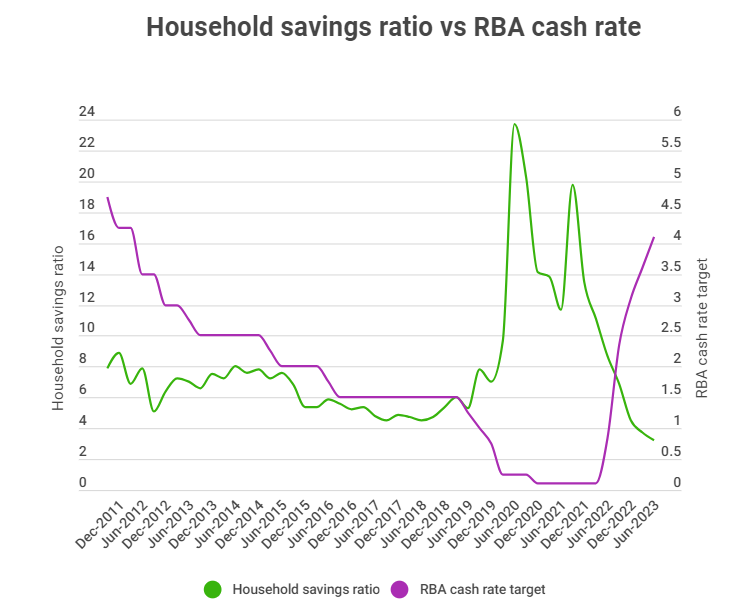This marks the seventh consecutive quarterly decline in the household savings ratio, as spending continues to outpace the growth in income.
- Household savings ratio falls from 3.6% to 3.2% in the June 2023 quarter.
- Savings ratio expected to decline in the short term, however an uplift could be seen in 2024.
- GDP lifts 0.4% quarterly and 2.1% annually in June 2023.
“The fall in the household savings ratio was driven by higher interest payable on dwellings, income tax payable, and increased spending by households due to rising cost of living pressures,” Katherine Keenan said, ABS Head of National Accounts.
To put the rate of decline into perspective, the household savings ratio sat at 13.5% in December 2021 off the back of significant savings buffers built through the pandemic.
The RBA noted within its August Statement of Monetary Policy (SoMP) that it expects the household savings ratio to continue to decline over the next year, before increasing gradually from mid-2024.
PRD Chief Economist Dr Diaswati Mardiasmo also believes household savings will decline in the short term due to the fact that previous cash rate hikes are still making their way through the market.
“Because of this delay, we are already seeing some extreme hits to our household savings rates but it is not to the full extent yet,” Dr Mardiasmo told Savings.com.au.
“There is a chance that the past three consecutive rate holds have made an impact, however this would be more of a ‘slowing down the decline’ type of impact as opposed towards a recovery where the household savings rate would be increasing.”

Should we be concerned about declining household savings?
Dr Mardiasmo said there are two ways to look at this.
“Yes we should because another decline puts us quite below the 10 year average,” she said.
“So, if something else should happen to us as a nation [pandemic], or if something should happen to the household [someone becomes sick], then we may not have the capacity to bear the extra costs without relying on some sort of debt method.
“But on the flipside, the significant declines we have seen were due to having an unprecedented amount of savings from COVID, which is not normal – so technically if we go by ‘normal times’ it is only slightly under.”
According to Dr Mardiasmo, a household savings ratio of 5% is a useful indicator of a robust economy.
GDP figures reveal 0.4% uptick in June quarter
The ABS revealed Australia’s economy expanded in the June quarter by 0.4% to reach an annual figure of 2.1%.
These quarterly increases have been gradually losing steam since early last year.
“This was the seventh straight rise in quarterly GDP, and annual growth remained above trend, reflecting the absence of significant COVID-19 disruptions, such as lockdowns in 2022-23,” Ms Keenan said.
”Capital investment and exports of services were the main drivers of GDP growth this quarter.”
AMP Chief Economist Shane Oliver remains concerned that the RBA has tightened more than necessary with a high (50%) risk of recession.
“Our view remains that the RBA has already done more than enough to slow the economy in order to rebalance demand and supply and bring inflation back to target,” Mr Oliver said.
“We are now seeing increasing evidence that rate hikes are biting with falling real retail sales, a sharp fall in building approvals, slowing business investment plans, slowing GDP growth, indications of a slowing jobs market, softer than expected wages growth, and a faster than expected fall in inflation.
“Given the lags involved and the increasing signs that monetary tightening is working it makes sense for the RBA to remain on hold so it can better assess the impact of the rate hikes.”
On a per capita basis, GDP was -0.3% over the quarter; it was -0.2% last quarter, placing the national economy under a per capita recession - the national economy goes backwards on a person-to-person basis.
It’s important to note the ABS revised the March GDP per capita data from the initial release of -0.2% to -0.3%. This means GDP per capita technically recorded back-to-back -0.3% declines in March and June.
"No slowing down as Australians’ savings buffers slip further away" was originally published on Savings.com.au and was republished with permission.
